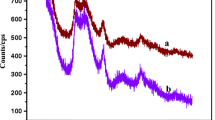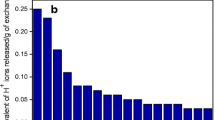Abstract
Nano tetrapod based on conducting polythiophene (PTh) and tin-phosphate (SnP) were synthesized by in situ chemical oxidative polymerization. The morphology of the resulting polythiophene tinphosphate composite was characterized by elemental analysis, fourier transform infrared spectroscopy, thermogravimetric analysis, powder X-ray diffraction, scanning electron microscopy and transmission electron microscopy. The physico-chemical characterization carried out on the composite showed that SnP was modified by conducting PTh with an enhancement of various properties. On the basis of highest distribution coefficient values for Hg(II), the composite was also used for the preparation of Hg(II) selective membrane electrode. The electrode showed working concentration range of 1 × 10−1 to 1 × 10−7 with Nernstian slope of 29.29 mV per decade change in concentration and the electrode may be used for wide working pH range of 4–8 having quick response time about 23 s. The life of electrode is 4 months without any notable drift in potential.








Similar content being viewed by others
References
Bahr JL, Tour JM (2002) Covalent chemistry of single-wall carbon nanotubes. J Mater Chem 12(7):1952–1958
Ebbesen TW (1996) Carbon nanotubes. Phys Today 49(6):26–32
Treay MMJ, Ebbesen TW, Gibson JM (1996) Exceptionally high Young’s modulus observed for individual carbon nanotubes. Nature 381(6584):678–680
Deheer WA, Chatelain A, Ugarte D (1995) A carbon nanotube field-emission electron source. Science 270(5239):1179–1180
Ruoff RS, Lorents DC, Chan B, Malhotra R, Subramoney S (1993) Single-crystal metals encapsulated in carbon nanoparticles. Science 259(5093):346–348
Tomita M, Saito Y, Hayashi T (1993) Lac2 encapsulated in graphite nano-particle. Jpn J Appl Phys 32(2B):L280–L282
Seraphin S, Zhou D, Jaio J, Withers JC, Loufty R (1993) Yttrium carbide in nanotubes. Nature 362(6420):503
Saito Y, Yoshikawa T, Okuda M, Ohkohchi M, Ando Y, Kasuya A, Nishina Y (1993) Synthesis and electron-beam incision of carbon nanocapsules encaging yc2. Chem Phys Lett 209(1–2):72–76
Rudodph AS, Calvert JM, Schoen PE (1988) In: Caber BP, Schnur JM, Chapman D (eds) Biotechnological applications of lipid microstructures. Plenum, New York
Wang C, Guo ZX, Fu S, Wu W, Zhu D (2004) Polymers containing fullerene or carbon nanotube structures. Prog Polym Sci 29(11):1079–1141
Shirakawa H (2002) The discovery of polyacetylene film: the dawning of an era of conducting polymers. Synth Met 125:3–10
MacDiarmid AG (2002) A novel role for organic polymers. Synth Met 125:11–22
Heeger AJ (2002) Semiconducting and metallic polymers: the fourth generation of polymeric materials. Synth Met 125:23–42
Skotheim TA (ed) (1986) Handbook of conducting polymers. Marcel Dekker, New York
Skotheim TA, Elsenbaumer RL, Reynolds JR (eds) (1998) Handbook of Conducting Polymers, 2nd edn. Marcel Dekker, New York
Waugaman M, Sannigrahi B, McGeady P, Khan IM (2003) Synthesis, characterization and biocompatibility studies of oligosiloxane modified polythiophenes. Eur Polym J 39(7):1405–1412
Okada A, Kawasumi M, Usuki A, Kojima Y, Kurauchi T, Kamigaito O (1990) Synthesis and properties of nylon-6/clay hybrids. In Schaefer DW, Mark JE, (eds) Polymer based molecular composites. Symposium proceedings, vol 171. MRS, Pittsburgh, 45
Giannelis EP (1996) Polymer layered silicate nanocomposites. Adv Mater 8(1):29–35
Giannelis EP, Krishnamoorti R, Manias E (1999) Polymer-silicate nanocomposites: model systems for confined polymers and polymer brushes. Adv Polym Sci 138:107–147
LeBaron PC, Wang Z, Pinnavaia TJ (1999) Polymer-layered silicate nanocomposites: an overview. Appl Clay Sci 15(1–2):11–29
Vaia RA, Price G, Ruth PN, Nguyen HT, Lichtenhan J (1999) Polymer/layered silicate nanocomposites as high performance ablative materials. J Appl Clay Sci 15(1–2):67–92
Biswas M, Ray S (2001) Recent progress in synthesis and evaluation of polymer-montmorillonite nanocomposites. Adv Polym Sci 115:167–221
Giannelis EP (1998) Polymer-layered silicate nanocomposites: synthesis, properties and applications. Appl Organomet Chem 12(10–11):675–680
Xu RU, Manias E, Snyder AJ, Runt J (2001) New biomedical poly(urethane urea)—Layered silicate nanocomposites. Macromolecules 34(2):337–339
Bharadwaj RK (2001) Modeling the barrier properties of polymer-layered silicate nanocomposites. Macromolecules 34(26):9189–9192
Messersmith PB, Giannelis EP (1995) Synthesis and barrier properties of poly(epsilon-caprolactone)-layered silicate nanocomposites. J Polym Sci, Part A: Polym Chem 33(7):1047–1057
Kojima Y, Usuki A, Kawasumi M, Fukushima Y, Okada A, Kurauchi T, Kamigaito O (1993) Synthesis of nylon 6-clay hybrid. J Mater Res 8(5):1179–1184
Gilman JW, Kashiwagi T, Lichtenhan JD (1997) Nanocomposites: a revolutionary new flame retardant approach. Sample J 33(4):40–46
Gilman JW (1999) Flammability and thermal stability studies of polymer layered-silicate (clay) nanocomposites. Appl Clay Sci 15(1–2):31–49
Dabrowski F, Bras ML, Bourbigot S, Gilman JW, Kashiwagi T (1999) PA-6 montmorillonite nanocomposite in intumescent fire retarded EVA. Proceedings of the Eurofillers’ 99. Lyon-Villeurbanne, France, 6–9 September 1999
Bourbigot S, LeBras M, Dabrowski F, Gilman JW, Kashiwagi T (2000) PA-6 clay nanocomposite hybrid as char forming agent in intumescent formulations. Fire Mater 24(4):201–208
Gilman JW, Jackson CL, Morgan AB, Harris JR, Manias E, Giannelis EP, Wuthenow M, Hilton D, Phillips SH (2000) Flammability properties of polymer—Layered-silicate nanocomposites. Polypropylene and polystyrene nanocomposites. Chem Mater 12(7):1866–1873
Clearfield A (2000) Inorganic ion exchangers, past, present, and future. Solv Extrn Ion Exch 18(4):655–678
Niwas R, Khan AA, Varshney KG (1999) Synthesis and ion exchange behaviour of polyaniline Sn(IV) arsenophosphate: a polymeric inorganic ion exchanger. Colloids Surf A Physicochem Asp 150(1–3):7–14
Niwas R, Khan AA, Varshney KG (1998) Preparation and properties of styrene supported zirconium(IV) tungstophosphate: a mercury(II) selective inorganic-organic ion exchanger. Indian J Chem 37(5):469–472
Khan AA, Alam MM (2003) Synthesis, characterization and analytical applications of a new and novel ‘organic-inorganic’ composite material as a cation exchanger and Cd(II) ion-selective membrane electrode: polyaniline Sn(IV) tungstoarsenate. React Funct Polym 55(3):277–290
Varshney KG, Tyal N, Khan AA, Niwas R (2001) Synthesis, characterization and analytical applications of lead (II) selective polyacrylonitrile thorium (IV) phosphate: a novel fibrous ion exchanger. Colloids Surf A: Physicochem Eng Asp 181(1–3):123–129
Varshney KG, Tayal N, Gupta U (1998) Acrylonitrile based cerium (IV) phosphate as a new mercury selective fibrous ion-exchanger—Synthesis, characterization and analytical applications. Colloids Surf A: Physicochem Eng Asp 145(1–3):71–81
Zhang B, Poojary DM, Clearfield A, Peng G (1996) Synthesis, characterization, and amine intercalation behavior of zirconium N-(phosphonomethyl)iminodiacetic acid layered compounds. Chem Mater 8(6):1333–1340
Alberti G, Casciola M, Dionigi C, Vivani R (1995) Proceedings of international conference on ion-exchange, ICIE’95. Takamtsu, Japan
Khan AA, Khan A, Inamuddin (2007) Preparation and characterization of a new organic-inorganic nano-composite poly-o-toluidine Th(IV) phosphate: its analytical applications as cation-exchanger and in making ion-selective electrode. Talanta 72(2):699–710
Srivastava SK, Jain AK, Agarwal S, Singh RP (1978) Studies with inorganic ion-exchange membranes. Talanta 25(3):157–159
Amarchand S, Menon SK, Agarwal YK (1998) Water hardness determination using Mg(II) ion selective electrode. Indian J Chem Technol 5(2):99–103
Duval C (1963) Inorganic thermogravimetric analysis. Elsevier, Amsterdam p315
Wang YD, Rubner MF (1990) stability studies of the electrical-conductivity of various poly(3-alkylthiophenes). Synth Met 39(2):153–175
Wang JX (1996) Mechanism of mediation of the electrochemical oxidation of K4Fe(CN)(6) at poly-[tris(3-{omega-[4-(2,2′-bipyridyl)]alkyl}-thiophene)iron(II)]-film modified electrodes in aqueous solutions. Electrochim Acta 41(16):2563–2569
Roncoli J (1992) Conjugated poly(thiophenes): synthesis, functionalization, and applications. Chem Rev 92(4):711–738
Toshima N, Hara S (1995) Direct synthesis of conducting polymers from simple monomers. Prog Polym Sci 20(1):155–183
Udum YA, Pekmez K, Yildiz A (2005) Electrochemical preparation of a soluble conducting aniline-thiophene copolymer. Eur Polym J 41(5):1136–1142
Amini MK, Mazloum M, Ensaf AA (1999) 10th working conference on applied surface analysis (AOFA 10) location: kaiserslautern, Germany, Date: SEP 06–10, (1998) Fresenius J Anal Chem 364(8):690–693
Demirel A, Dogan E, Canel E, Memon S (2004) Hydrogen ion-selective poly(vinyl chloride) membrane electrode based on a p-tert-butylcalix[4]arene-oxacrown-4. Talanta 62(1):123–129
IUPAC Analytical Chemistry Division, Commission on Analytical Nomenclature (1994) Recommendations for nomenclature of ionselective electrodes (IUPAC Recommendations 1994). Pure Appl Chem 66:2527–2536
Jumal J, Yamin BM, Ahmad M, Heng LY (2012) Mercury Ion-Selective Electrode With Self-plasticizing Poly(nbuthylacrylate) Membrane Based On 1,2-Bis-(N′-benzoylthioureido)cyclohexane As Ionophore. APCBEE Procedia 3:116–123
Gupta VK, Singh AK, Khayat MA, Gupta B (2007) Neutral carriers based polymeric membrane electrodes for selective determination of mercury (II). Anal Chim Acta 590:81–90
Mazloum M, Amini MK, Baltork IM (2002) Mercury selective membrane electrodes using 2-mercaptobenzimidazole, 2-mercaptobenzothiazole and hexathiacyclooctadecane carriers. Sens Actuators, B 63:80–85
Lu J, Tong X, He X (2003) A mercury ion-selective electrode based on a calixarene derivative containing the thiazole azo group. J Electroanal Chem 540:111–117
Mahajana RK, Puria RK, Marwahab A, Kaur I (2009) Mohinder Pal Mahajanb, Highly selective potentiometric determination of mercury(II) ions using 1-furan-2-yl-4-(4-nitrophenyl)-2-phenyl-5H-imidazole-3-oxide based membrane electrodes. J Hazard Mater 167:237–243
Acknowledgments
We are thankful to the Centre of Excellence for Advanced Materials Research (CEAMR), King Abdulaziz University, KSA to carry out experiments on this work.
Author information
Authors and Affiliations
Corresponding author
Rights and permissions
About this article
Cite this article
Khan, A., Asiri, A.M., Khan, A.A.P. et al. Sol–gel synthesis and characterization of conducting polythiophene/tin phosphate nano tetrapod composite cation-exchanger and its application as Hg(II) selective membrane electrode. J Sol-Gel Sci Technol 65, 160–169 (2013). https://doi.org/10.1007/s10971-012-2920-6
Received:
Accepted:
Published:
Issue Date:
DOI: https://doi.org/10.1007/s10971-012-2920-6




